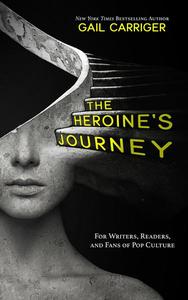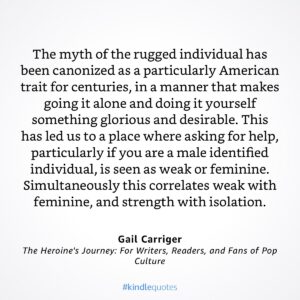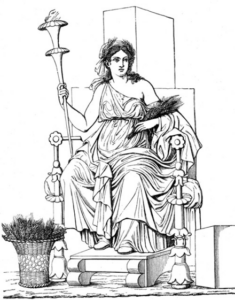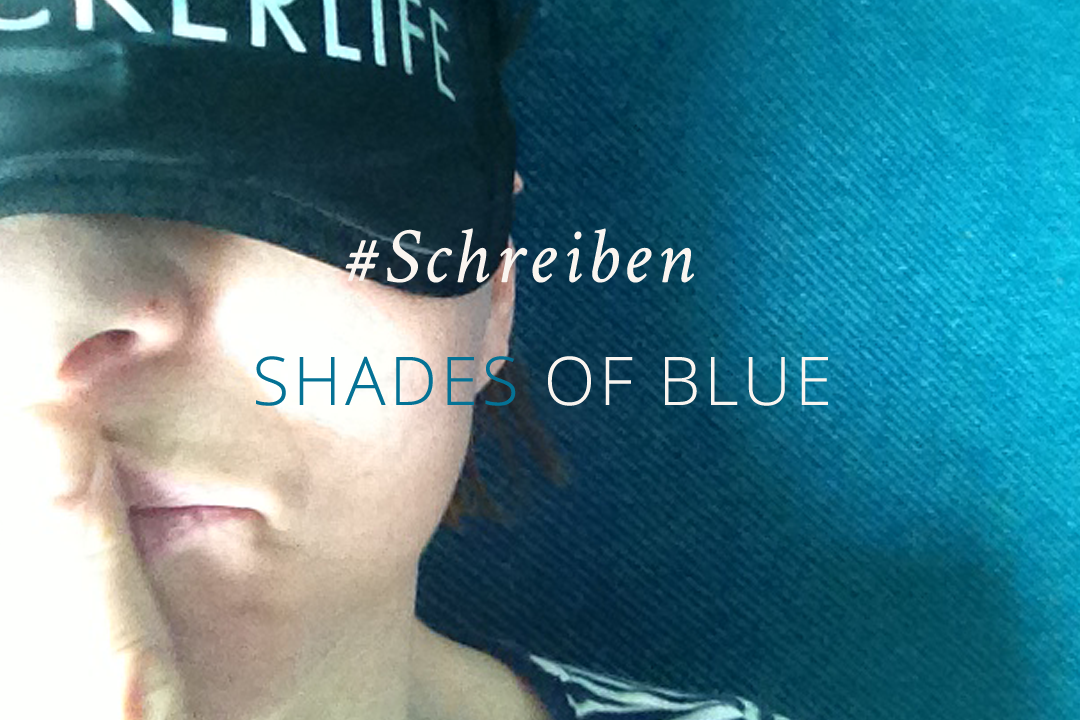The Heroine’s Journey
The Heroine’s Journey is a separate narrative structure from the Hero’s Journey. It Exists. It has always existed. (Gail Carriger – The Heroine’s Journey)
 Never was the publication of a book more exciting for me. I read so many books about story writing and script writing but one piece was still missing. One perspective. And here it is. Gail Carriger, super intelligent, an academic, a fast writer of novels most would shame for being trivial, wrote it: The Heroine’s Journey by Gail Carriger.
Never was the publication of a book more exciting for me. I read so many books about story writing and script writing but one piece was still missing. One perspective. And here it is. Gail Carriger, super intelligent, an academic, a fast writer of novels most would shame for being trivial, wrote it: The Heroine’s Journey by Gail Carriger.
A book about the Heroine’s Journey, my friends, needs more words. And if you don’t intend to read Carriger’s book, I hope you will when I tell you, what’s all about and why it so important. Not only for writers but also for readers.
I decided to write this article in Englisch, because it’s too important (not my writing but this topic) to write it in German. But keep in mind, that I’m not a native speaker, my English is very likely not perfect and a bit rocky. Please send me a comment, if you find something really weird or wrong.
So I’m going to explain everything about the heroine’s story but first, let me go back to the times, were there was only a Hero’s Journey – or – we writers and screenwriters thought so, because the Heroine’s Journey was always there.
The Hero*s Journey
 The Hero’s Journey is the story model we all know. At least unconsciously. A super strong hero (or a heroine!) must leave the familiar world and goes on a journey. The (and I stick with „hero“ but it could also be a heroine) hero first refuses and then goes on his journey.
The Hero’s Journey is the story model we all know. At least unconsciously. A super strong hero (or a heroine!) must leave the familiar world and goes on a journey. The (and I stick with „hero“ but it could also be a heroine) hero first refuses and then goes on his journey.
He meets his mentor, gets advice and stays on his quest to gain a certain goal: A sword, a special place, a kingdom, the grail – whatever. Also: A wife. Yes, a wife is a goal in the Hero’s Journey, because it’s all about goals and winning.
The Hero’s Story is not about love and compassion, it’s about a quest. About winning and getting things, about being the best in the field, the winner.
Sounds familiar? Sounds like you know this from life? Your work place? Your University? Getting a degree? Getting a work place, climbing up the ladder to be at the top? Well. We all know this story, we grew up with it. If you’re a winner, you fight all along to the top.
This is ist also the crucial thing about the Hero’s Journey: It’s always about getting and winning and being on a quest. Never about grounding and founding and settling. And it’s also the most significant difference between the Hero’s and the Heroine’s Story.
The Lonesome Hero
When the hero reaches his goal – after fights against villains, after hard work, after winning his different goals – he is still alone. Coming back is possible, but starting a family? Living a life in the community? Is not in his book. He only waits for the next journey to come. The next world to save.
We all know this kind of hero. He fights for – whatever – he ist successful and he returns – only to go on the next quest. And – this is important – he always and forever stays alone. And if you disagree, because the hero has a love interest and maybe has rescued her or him – think of all the superheroes. For example Spiderman. The hero maybe is in love with someone – but in the end, he has to leave and save the (next) world.
This story model is very archaic but it’s the story model most superhero movies are based on. And most of the crime stories and most of the fantasy stories. And this is okay. It’s still good to know, that they are strong and heroic creatures out there, that fight for goals. Think of soldiers. (Well maybe and hopefully an obsolete job in the future).
But there are people – not necessarily women – who crave for other goals and stories. This story is the Heroine’s Journey and it’s time to recognise it.
The Heroine’s Journey
With great relieve I now turn to the Heroine’s Journey. Which – like I mentioned – was always there.
Carriger retells three example stories of goddesses to introduce us to the concept of the Heroine’s Journey: Demeter, Isis and Inanna. „… three Heroines‘ Journeys myths to help provide a foundational understanding of this core narrative.“ She provides us with the narrative beats of the Heroine’s Story. (Position 687 Kindle Edition):
- The Descent (loss or separation)
- Familie network is broken
- Pleas are ignore, abdication of power, involuntary withdrawal
- Isolation, danger, risk
- The search, disguise/subversion
- Attempt to rebuild community
- Underworld and the following ascent
- Success in her search
- Negotiations and Compromises that benefit all
- A new network is re-etablished in an altered form (revenge & glory are irrelevant)
The Heroine’s Journey is one of building teams, creating cohesions, forming social relationships, ensuring civilizations and posterity. It also seeks balance and compromise. (G. Carriger, Position 698 Kindle edition)
Not every Hero’s Journey contains all the beats and it’s the same with the Heroine’s Journey. What is important: The Heroine is also on a quest – but she doesn’t think, she had to fight alone. She seeks for allies, she makes compromises and negotiates. And in the end – she finds a new network or community.
„A heroine will compromise to achieve that goal. This is not a weakness. This is the very definition of what makes her a strong protagonist within the framework of this journey.“ (Pos 1121 Kindle Edition)
Well, maybe you notice, that there are many stories out there, that are like the Heronie’s Story. Right.
Lovestories and other Heroine’s Journeys
Harry Potter is a Heroine’s Journey. That is maybe a surprise. (Read more about it in Carriger’s book). Harry lost his family and is finding a new one at Hogwarts and later on in his friends. And when he is on his journey, he uses the abilities of Hermine or Ron and cares about them.
„The heroine (male or female) is in a position of greatest strength when she is in a group.“ (Pos 1307 Kindle Edition)
Romance stories are also most of the time Heroine’s Journeys.
„This is why engagements, weddings, parties, and sex scenes are so important in Heroine’s Journey narratives – this tend to highlight ask three kinds of intimacy at once.“ (Pos 1312 Kindle Edition)
The Definition of Success
The Heroine’s Story also changes the definition of success. Heros fight for certain goals and achievements. Heroines not so much.
„For our heroine, friendship and found family signify safety and safety is better than glory. A heroine success by building a network. For her, the very definition of success therefore is unity.“ (1367 Postion Kindle Edition)
The hero or the concept of the hero – is great, but he or she is very rarely needed in the every day life. And if you like to write more realistic (but hopefully not boring) stories, you may have a problem with the old Hero’s Journey. So if you ask yourself as a writer, why some structures are not working for your story use the Heroine’s Journey instead. Especially when you’re writing in the romance genre.
Heroes in Heroine’s Stories
 Carriger also mentions in her book, that the love interest in romances is often a man who acts and behaves like the hero in the Hero’s Journey. The lonesome cowboy. Arrogant and cold. This very popular character – the bad boy – is loved by most romance novel readers. And he is mostly changed by a heroine – not very realistic – in a soft purring cat.
Carriger also mentions in her book, that the love interest in romances is often a man who acts and behaves like the hero in the Hero’s Journey. The lonesome cowboy. Arrogant and cold. This very popular character – the bad boy – is loved by most romance novel readers. And he is mostly changed by a heroine – not very realistic – in a soft purring cat.
It’s very interesting, when Hero’s and Heroine’s Journeys blend in each other. There are endless possibilities for new stories here.
So Carriger’s book is not only a very intelligent book about story structure, but also a book about the future of writing, and our society, comment on Pop Culture and the relationship between men and women.
More insides
I wrote on the Red Bug Culture Blog about the Hero’s Journey (in German), so check it out, if you’re interested in a simple overlook and explanation. If you want to dig deeper – here is a list of books.
The Hero’s Journey
- A Skeleton Key to Finnegans Wake (1944)
- The Hero with a Thousand Faces (1949)
- Creative Mythology (1968)
- The Flight of the Wild Gander (1968)
- Myths to Live By (1972)
- The Inner Reaches of Outer Space (1986)
- Historical Atlas of World Mythology (1983–1989)
- The Power of Myth (1988)
- The Hero’s Journey (1990)
- Thou Art That (2001)
The Heroin’s Journey
- The Heroine’s Story by Gail Garriger (2020)
- The Heroin’s Journey by Maureen Murdock (1990)
- The Virgin’s Promise by Kim Hudson (2010)
More
- Women Who run with the Wolfes Myths and Stories of the Wild Woman Archetype (2003)
- The Virgin’s Promise: Writing Stories of Feminine Creative, Spiritual, and Sexual Awakening (2011
And I speak in the Red Bug Radio Podcast about the Hero’s Journey and the Heroine’s Journey (also in German).









No Comments